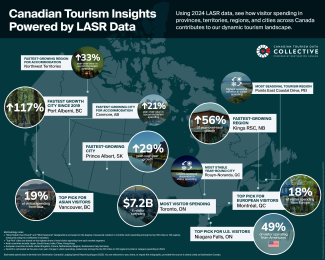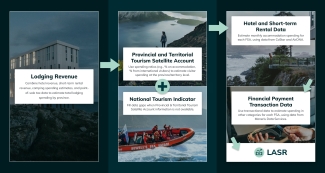Discover how and where visitors are spending their travel dollars in Canada.
What is LASR?
LASR (Lodging Aligned Spend Reporting) is Canada’s premier visitor spending model, offering reliable estimates of in-destination visitor spending nationwide.
Whether you manage a destination, research market trends, or shape tourism policy, LASR provides the insights you need to understand visitor spending patterns - where, when, from who, and on what.
Detailed monthly estimates of visitor spending across Canada capture data from the U.S., overseas, and domestically.
In the past, visitor spending measures relied on one survey input and displayed data at the provincial and territorial level with 150 days’ delay, giving users a limited and outdated view of Canadian tourism spending.
By contrast, the LASR model incorporates visitor spending from 1,600+ FSAs, with zero lag, six months’ projections and six integrated signals – a real-time, 360 view of spending trends and forecasts, from coast to coast to coast.
LASR at a Glance
The First and Only of its Kind
provinces and territories' tourism spending tracked with LASR
tourism regions' spending performance to measure and analyze
cities included in LASR reporting, from coast to coast to coast
FSAs (Forward Sortation Areas) included, tracking visitor spending by postal zone
Use LASR to
- Understand visitor spending behaviour at a national, provincial/territorial, regional, and city level.
- Guide tourism strategy decisions using reliable spending data.
- Measure ongoing performance of tourism initiatives to identify success stories and opportunities to grow.
From national associations to local destination marketing organizations, partners rely on LASR to understand visitor spending at a micro and macro level.

How It Works
Built on a secure, cloud-based analytics platform, LASR integrates:
- Lodging data from hotels and short-term rentals
- Transaction data from anonymized payment records
- Tourism Satellite Accounts from Statistics Canada
- AI-powered data processing and quality assurance
By combining trusted data sources with automation and AI, LASR equips tourism leaders, planners, and researchers with credible, localized intelligence - from the postal code level to cities and tourism regions - helping them monitor trends, allocate resources, and plan for the future with confidence.
See how the model flows from data to insights in the diagram below.
LASR’s dashboards allow exploration of visitor spending across various geographic levels and time frames. View insights by province or territory, tourism region, and city, or explore a dedicated page for national trends and visitor origin markets.
Year-to-date, full-year, and comparative set analysis views are available to help you better understand tourism activity across Canada.

Hear from our Partners
Current subscribers include:
- Provincial and territorial destination marketing organizations (PTDMOs)
- Regional tourism associations and destination management organizations
- City and municipal DMOs
- Federal departments and agencies
- National tourism and industry associations
Hear from our partners on how they benefit from reliable visitor spending data to enhance their tourism initiatives.
Explore real-world examples of how LASR data is being utilized.
See how different regions leverage LASR insights to drive tourism strategies and decision-making.

Yukon
Tourism Yukon combined LASR data with insights from the Yukon Business Survey to estimate tourism revenue from 2018 to 2025, providing the public with a key indicator of the territory’s tourism economy.

Nova Scotia
Tourism Nova Scotia uses LASR spending estimates, combined with provincial data, to measure tourism revenues and their economic impact, capturing spending by visitors and residents across key categories such as accommodations, transportation, and recreation.
Real-World Experiences. Real Wins for Tourism
Frequently Asked Questions
What is the definition of “visitor”?
LASR follows Statistics Canada’s definition of visitor: “A visitor is a traveller taking a trip to a main destination 40+km away from his/her usual environment, for less than a year, and for any main purpose (business, leisure or other personal purpose) other than to be employed by a resident entity in the country or place visited.”
The concept of tourism is broad, covering more than just ‘leisure travel’; it includes travel for business, leisure and other personal reasons, such as visiting friends and relatives, as well as same day and overnight travel.
How can I subscribe to access the full LASR dashboards and data?
LASR is available to Canadian Tourism Data Collective subscribers. If you are interested in accessing the full dashboards or receiving data files, please contact us to inquire about subscription options.
How are cities defined?
Cities are defined based on Canada Post’s definition as well as STR's database of hotel inventory in Canada. For an FSA (Forward Sortation Area) to be included in a city, it must have at least 200 hotel rooms and possess at least 80% of all hotel rooms in the FSA.
Can I change the geographic definition of my city?
Please contact us with the FSAs you would like to see included in your city, and we will work with you and the provincial/territorial DMOs to standardize the regions.
Can we share LASR data outside of my organization?
LASR access is provided to organizations that have signed up for a Canadian Tourism Data Collective subscription (Partners). Conditional data sharing consent for some common external use cases can be found on the LASR product page on the Data Collective. Additional requests for public sharing can be sent to the Data Collective with detailed information on a case-by-case basis and require explicit written consent from DC.
Can I receive CSV data delivery of my city/region?
CSV files of LASR estimates can be delivered to Partners via a Secure File Transfer Protocol service hosted by Destination Canada. Once signed up for Data Collective subscription, please refer to LASR Data Extraction Document on each LASR page for more details or contact us if you would like to receive LASR CSV files.
Are year-to-date monthly preliminary spending estimates subject to revision?
Yes, LASR provides two types of estimates: monthly preliminary and annual final estimates. The preliminary estimates are based on the most recent transaction and accommodation revenue data, but they use older Provincial and Territorial Tourism Satellite Account (PTTSA) & National Tourism Indicators (NTI) data due to a lag in reporting. While we don't expect significant changes in category spending shares, these preliminary estimates are subject to revision at annual finalization. For example, the 2024 estimates will be finalized in 2025 once Statistics Canada releases the final quarterly report for 2024 NTI.
Why could LASR estimates be different from Tourism Outlook total tourism spending?
The two products use different methodological approaches to estimate spending in different definitions. LASR focuses on in-destination visitor spending, while Tourism Outlook could include pre-trip spending, such as international airfare. Please refer to detailed methods to better understand data definitions on different products and use them to serve your analysis or business purposes accordingly.



